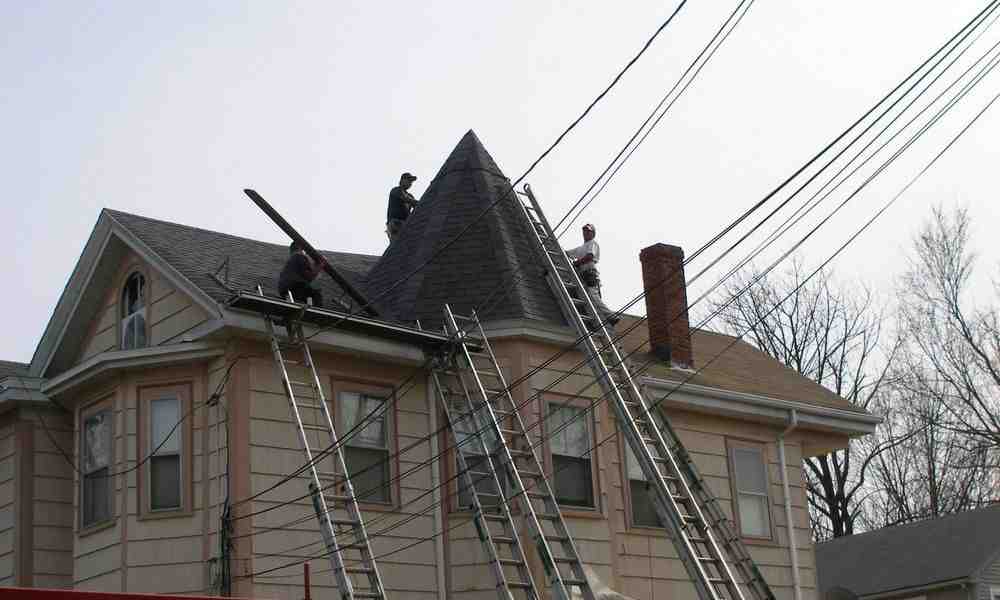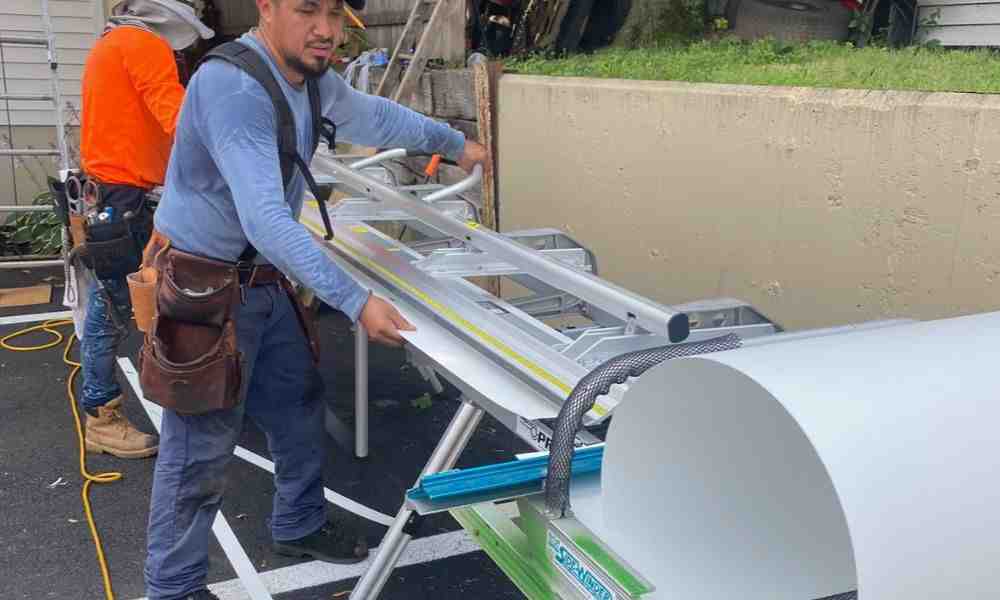The #1 Resource for Everything About Roofers in 2024
Understanding Roofers and Their Work
Roofers are essential professionals in the roofing industry, responsible for the construction, repair, and maintenance of roofs on buildings. They use various materials like shingles, metal, and tiles to ensure the roof is durable and weather-resistant. Given the physical demands and safety risks, such as heights and extreme weather, roofers must be skilled, patient, and precise.
Quick Facts about Roofers:
– Primary Tasks: Replace, repair, and install roofs.
– Materials Used: Shingles, metal, tiles, and more.
– Work Conditions: Physically demanding and often risky.
– Emerging Trends: Solar roofs; increased interest in metal roofs.
My name is Jack Golini, and I’ve been leading Golini Roofing in Wakefield, MA, for over 35 years. My extensive experience ensures top-quality craftsmanship and complete customer satisfaction in all your roofing needs.

What Roofers Do
Types of Roofing Services
Roofers are essential for keeping your home or business safe and dry. They perform a variety of tasks including replacing, repairing, and installing roofs. Here’s a quick overview:
- Replace Roofs: When a roof is beyond repair, roofers will completely remove the old roofing materials and install a new roof. This is often necessary for older roofs or those severely damaged by storms.
- Repair Roofs: For less severe damage, roofers can repair specific areas. This might involve fixing leaks, replacing missing shingles, or addressing damage from a fallen tree.
- Install Roofs: New construction projects require roofers to install roofs from scratch. This includes laying down the decking, underlayment, and the final roofing material.
- Roof Maintenance: Regular maintenance can extend the life of your roof. Roofers can perform inspections, clean gutters, and remove debris to prevent damage.
Roofers work on both residential and commercial properties. Residential roofing deals with homes and small buildings, while commercial roofing involves larger structures like office buildings and warehouses.
Residential Roofing
Residential roofing services include:
– Roof Inspections: Regular inspections can catch problems early. Roofers look for signs of wear and tear, leaks, and structural issues.
– Roof Repairs: Quick fixes to prevent minor issues from becoming major problems.
– Roof Replacement: Complete overhaul when the roof is too damaged to repair.
Commercial Roofing
Commercial roofing services are more complex due to the size and type of buildings:
– Roof Inspections: Similar to residential but often more detailed due to the larger area.
– Roof Repairs: Specialized techniques to handle the unique challenges of commercial roofs.
– Roof Replacement: Involves careful planning to minimize disruption to business operations.
Common Roofing Materials
The materials used by roofers vary depending on the type of building and the climate. Here are some common options:
- Shingles: The most popular choice for residential roofs. They come in various styles, including asphalt shingles, which are cost-effective and easy to install.
- Metal Roofing: Known for its durability and longevity. Metal roofs can withstand extreme weather and are often used in both residential and commercial settings.
- Composite Shingles: Made from a blend of materials to offer the best features of each. They are durable, lightweight, and can mimic the look of more expensive materials like slate or wood.
- Roof Ridge Vents: These are crucial for proper ventilation. They help regulate temperature and moisture levels in the attic, extending the life of your roof.
Quick Tip: Regular inspections and maintenance can significantly extend the lifespan of your roof, regardless of the material used.
In the next section, we’ll dig into how to hire a reliable roofer, ensuring you get the best service for your roofing needs.
How to Hire a Reliable Roofer
Finding a reliable roofer is crucial for ensuring your roof is installed or repaired correctly. Here are some key steps and questions to guide you through the process.
Questions to Ask Potential Roofers
1. How long have you been in the roofing business?
Experience matters. Roofers with years in the industry have likely encountered and solved various roofing problems. For example, Golini Roofing boasts over 35 years of dedicated service, which is a testament to their reliability and skill.
2. Do you offer warranties on your work?
A good warranty shows that the contractor stands behind their work. It also provides peace of mind that any post-installation issues will be addressed.
3. What types of insurance do you have?
Ensure the contractor has both general liability and workers’ compensation insurance. This protects you from any liabilities in case of accidents during the project.
4. Can you provide references or customer reviews?
Talking to previous clients or reading reviews can give you an idea of what to expect. Look for consistent positive feedback on quality and service. For instance, Golini Roofing has a stellar reputation with thousands of satisfied customers.
5. Do you work with homeowner’s insurance to file claims?
If your roof replacement is due to storm damage, a contractor experienced in dealing with insurance claims can simplify the process.
6. Will you give me a written estimate after the inspection?
A detailed estimate helps you understand the costs involved and prevents surprises later.
Avoiding Roofing Scams
Unfortunately, roofing scams are all too common. Here are some tips to protect yourself:
1. Get more than one estimate.
Don’t let one contractor pressure you into hiring them for the job. Multiple estimates give you a better understanding of the market rate.
2. Work with licensed and insured contractors.
While not all states require roofing contractors to be licensed, it’s a good idea to check if your state does. Ask to see proof of contractor’s liability insurance and make sure the policy’s effective dates haven’t expired.
3. Do your research.
Check if the contractor is a member of any local, state, regional, or national roofing industry associations. Verify if they’ve had any complaints filed with the Better Business Bureau.
4. Get a signed contract before the work begins.
Make sure it specifies the cost, time schedules, payment schedules, guarantees, and any other expectations. Do not leave any portion of the contract blank.
5. Coordinate with your insurance company.
Ensure your adjuster inspects the damage before repairs begin. Your claim could be denied if the insurance company doesn’t inspect the damage first.
6. Pay with a check or credit card.
Do not pay in cash. Do not pay the contractor in full or sign a completion certificate until the work is completed to your satisfaction and in compliance with local building codes.
Quick Tip: If you suspect a roof repair scam, contact your state’s insurance fraud bureau or the NICB.
In the next section, we’ll look at the costs associated with roofing services and what factors can affect these costs.
Cost of Roofing Services
Factors Affecting Roofing Costs
Roofing costs can vary widely based on several factors. Here are the main ones to consider:
1. Roof Size
Larger roofs require more materials and labor, increasing the overall cost. For example, a 1,000 sq. ft. roof might cost around $7,000, while a 3,000 sq. ft. roof could go up to $21,000.
2. Roofing Materials
The type of roofing material you choose plays a significant role in cost. Asphalt shingles are generally more affordable, costing around $7 per square foot. In contrast, metal roofs are more durable but can cost up to $40 per square foot.
3. Labor Costs
Labor can account for up to 60% of your total cost. In regions with higher living costs, like California, labor charges can be higher, ranging from $40 to $60 per hour. In areas with lower costs, like Texas, labor might be cheaper.
4. Project Complexity
The complexity of the project also affects costs. High-pitched or multi-layered roofs often require specialized skills and materials, driving up your costs.
5. Additional Repairs
Sometimes, roof replacement requires additional repairs, such as fixing the underlayment or replacing damaged decking. These repairs add to the overall cost but are essential for the longevity of your new roof.
Cost Breakdown for Common Roofing Projects
1. Roof Replacement Costs
Replacing a roof is often more expensive than repairing it. On average, homeowners spend between $5,890 and $12,800 to replace a roof. The size, pitch, and number of stories of your house will significantly affect the overall cost. For large, high-end roofs, you could spend upwards of $46,000.
2. Roof Repair Costs
Typical roof repairs cost between $380 and $1,800 on average. However, most homeowners spend around $1,100 on a repair project. The extent of the damage and the type of project all impact the final cost. For example, repairing damaged gutters might cost between $180 to $560, while fixing a sagging roof can range from $1,500 to $7,000.
3. Dormer Addition
Adding a dormer to your roof can increase your living space and add natural light. However, this is a complex project that typically costs between $2,500 and $20,000, depending on the size and style of the dormer.
4. Roof Heat Cables
Installing roof heat cables can prevent ice dams and snow buildup. The cost for this project ranges from $400 to $1,200, depending on the length of the cables and the complexity of the installation.
Understanding these factors can help you get a clearer picture of what to expect and how to budget for your roofing project. In the next section, we’ll explore the work environment of roofers and the safety measures they take to ensure their well-being on the job.
The Work Environment of Roofers
Roofing is one of the most physically demanding jobs out there. Roofers spend a lot of time climbing, bending, kneeling, and doing heavy lifting. They also work at heights, often on slanted surfaces, which adds to the challenge.
Safety Measures for Roofers
Given the risks, safety is a top priority. Here are some key safety measures:
Safety Equipment: Roofers use a variety of safety gear, including harnesses, hard hats, and non-slip shoes. This equipment helps protect them from falls and other injuries.
Fall Protection: Falls are the leading cause of injuries and fatalities in roofing. To prevent falls, roofers use personal fall arrest systems, guardrails, and safety nets. These measures are crucial, especially since the rate of fatalities from falls among roofers is significantly higher than in other construction jobs.
Weather Considerations: Roofers often work in extreme weather conditions, from scorching heat to freezing cold. Working in such conditions can be dangerous. For instance, extreme heat can lead to heatstroke, while icy surfaces increase the risk of slips and falls. Roofers need to stay hydrated, take breaks, and wear appropriate clothing for the weather.
Safety Training: Proper training is essential for reducing risks. Roofers undergo safety training to learn how to use their equipment correctly and recognize potential hazards. This training can make a big difference in preventing accidents.
Inspections: Before starting a job, roofers inspect their ladders and other equipment to ensure they are in good condition. This step is crucial for preventing accidents caused by faulty equipment.
By following these safety measures, roofers can protect themselves while doing their demanding and vital work. In the next section, we’ll look at the job outlook and career path for roofers.
Job Outlook and Career Path for Roofers
Becoming a Roofer
Roofers play a vital role in the construction industry. The job outlook for roofers is stable, with employment projected to grow by 2% from 2022 to 2032, according to the latest data. This growth is about as fast as the average for all occupations. Each year, there are expected to be around 12,200 job openings for roofers. Many of these openings will result from the need to replace workers who transfer to different occupations or retire.
Career Advancement
Starting as a roofer can lead to various career advancements. Many roofers begin their careers with on-the-job training, where they learn the skills needed for the job directly from experienced professionals. This hands-on experience is invaluable and often the primary method of training in this field.
Some roofers choose to advance their careers by becoming supervisors or starting their own roofing businesses. With additional training and experience, roofers can also specialize in areas such as solar roof installation or metal roofing, which are emerging trends in the industry.
Apprenticeship Programs
While there are typically no formal education requirements to become a roofer, apprenticeship programs are an excellent way to gain in-depth knowledge and experience. These programs usually last three years and combine paid on-the-job training with classroom instruction. Apprenticeships cover a wide range of skills, including safety practices, roofing materials, and installation techniques.
On-the-Job Training
Most roofers learn their trade through moderate-term on-the-job training. During this period, new roofers work under the guidance of experienced workers, learning how to handle tools, materials, and safety equipment. This practical training helps them develop the skills needed to perform their job effectively.
No Formal Education
One of the attractive aspects of becoming a roofer is that there are no formal educational credentials required. This makes it an accessible career option for many people. Instead of attending college, aspiring roofers can start working and earning money while they learn the trade.
Skill Development
Working as a roofer requires a variety of skills. Roofers need to be physically fit, as the job involves climbing, bending, kneeling, and lifting heavy materials. Attention to detail and the ability to follow safety protocols are also crucial. Over time, roofers can develop specialized skills, such as installing different types of roofing materials or working on complex roofing systems.
In summary, becoming a roofer offers a stable career path with opportunities for advancement. Whether through on-the-job training, apprenticeships, or starting without formal education, there are many ways to enter and grow in this essential trade. Next, we’ll explore some frequently asked questions about roofers to provide even more insight into this career.
Frequently Asked Questions about Roofers
What is the highest pay for a roofer?
Roofers can make a decent living, but their pay can vary widely. According to the latest data, the median annual wage for roofers is $50,030, or about $24.05 per hour. However, top earners in the field can make significantly more.
Experienced roofers with specialized skills or those working in high-demand areas can earn upwards of $70,000 per year. Factors like geographic location, type of roofing work, and years of experience can all influence how much a roofer earns.
Why do roofers have a bad reputation?
Unfortunately, the roofing industry has its share of bad apples, which can lead to a poor reputation. Some common issues include:
- Poor Quality Work: Some roofers may cut corners to save time or money, resulting in subpar work that doesn’t last.
- Customer Dissatisfaction: When roofers don’t meet expectations, it leads to unhappy customers and negative reviews.
- Cutting Corners: Using cheaper materials or skipping essential steps can lead to long-term problems for homeowners.
- Cheaper Quotes: Some roofers might offer low quotes to win jobs but then tack on additional costs later.
To avoid these issues, it’s crucial to hire a reputable roofing contractor with good references and proper certifications.
What does “roofer” mean?
A roofer is a skilled tradesperson who specializes in roof construction, repair, and maintenance. They work on various types of roofs, including shingles, metal, and composite materials. Here are some key roles:
- Roof Construction: Building new roofs from scratch.
- Roof Repair: Fixing leaks, replacing damaged shingles, and addressing other issues.
- Roof Mechanic: A more specialized term for a roofer who works on mechanical elements of the roof, like ventilation systems.
- Roofing Contractor: A professional or company that provides comprehensive roofing services, including installation, maintenance, and repair.
Roofers play a vital role in protecting homes and buildings from the elements, ensuring structural integrity, and enhancing property value.
Conclusion
At Golini Roofing, we take pride in delivering exceptional craftsmanship and ensuring customer satisfaction. Our team of experienced roofers is dedicated to providing top-quality roofing services that stand the test of time.
Exceptional Craftsmanship
One of the things that set us apart is our commitment to craftsmanship. We use techniques like hand-nailing each shingle to ensure superior durability and weather resistance. This meticulous attention to detail means that your roof will not only look great but also offer robust protection against the elements for years to come.
Customer Satisfaction
We understand that getting a new roof is a significant investment. That’s why we strive to make the process as smooth and stress-free as possible. From the initial consultation to the final inspection, we keep you informed and involved every step of the way. Our goal is to exceed your expectations and leave you completely satisfied with our work.
When you choose Golini Roofing, you’re not just getting a new roof; you’re getting peace of mind. We back all our work with a warranty, providing you with the confidence that your new roof will offer comfort, protection, and shelter for many decades to come.
Learn more about our residential roofing services and schedule a free roof inspection today!
Doesn’t your home deserve a hand-nailed, top-quality Golini roof?


